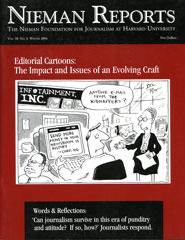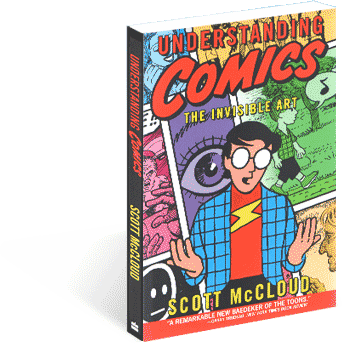SJMC instructor Jim Danky recently asked an intriguing question on our internal email list, and I thought it would be a good topic to open up on the weblog (with his permission):
Yesterday I received a question from Victor Navasky that I could not answer beyond some anecdotes so I am asking for assistance. (And yes, the answer is of interest to me as well).
Why do cartoons often have a greater impact than words? Sometimes more than photographs? Given that we live in the age of mechanical reproduction, why is it that something from the head and hand remains in our memory longer than words on occasion?
Historians and quantifiers, all ideas and citations warmly received.
 My own response was to point to this special issue of Nieman Reports from 2004, on “Editorial cartoons: The impact and issues of an evolving craft.” For example, communication professor Chris Lamb wrote:
My own response was to point to this special issue of Nieman Reports from 2004, on “Editorial cartoons: The impact and issues of an evolving craft.” For example, communication professor Chris Lamb wrote:
When editorial cartoons are at their best, they’re like switchblades—simple and to the point. They cut deeply and leave a scar. No editorial on President Lyndon B. Johnson’s administration is as memorable as David Levine’s drawing of LBJ lifting up his shirt to reveal his gall bladder scar in the shape of Vietnam. Herbert Block, or Herblock as he signed his cartoons, captured the anti- Communist hysteria of the Red Scare by creating the word “McCarthyism.” Later, Herblock’s portrayal of Richard Nixon climbing out of a sewer made such an impression on Nixon that he later told an adviser, “I have to erase the Herblock image.” Robert Minor’s searing World War I cartoon of a medical examiner salivating over a giant headless soldier and gushing, “At last a perfect soldier!” is a timeless indictment of war. And Thomas Nast’s drawing of “Boss” Tweed as a bag of money remains an enduring symbol of political corruption.
But as editorial cartoonist Bruce Plant pointed out,
It’s not a pretty picture. The number of editorial cartoonist staff positions has dwindled from a high of almost 200 in the mid-1980’s to about 85 now.
 My own view on the power of cartooning has been shaped by Scott McCloud’s wonderful volumes on Understanding Comics (1993), Reinventing Comics (2000), and Making Comics (2006), where he explores how “The heart of comics lies in the space between the panels where the reader’s imagination makes still pictures come alive,” substituting the flow of space for the passage of time. This is a unique and imaginative medium, he argues:
My own view on the power of cartooning has been shaped by Scott McCloud’s wonderful volumes on Understanding Comics (1993), Reinventing Comics (2000), and Making Comics (2006), where he explores how “The heart of comics lies in the space between the panels where the reader’s imagination makes still pictures come alive,” substituting the flow of space for the passage of time. This is a unique and imaginative medium, he argues:
Comics’ place in society is vital […] as one of the few forms of personal communication in a world of committee-built automatons and corporate mass-marketing. Comics offers a medium of enormous breadth and control for the author, a unique, intimate relationship with its audience, and a potential so great, so inspiring, yet so brutally squandered, it could bring a tear to the eye. [McCloud S 2000, p. 3]
What do Mediated Communication readers think? Do cartoons and comics matter in journalism and mass communication? In politics and the public sphere? If so, then why?
